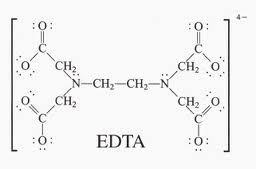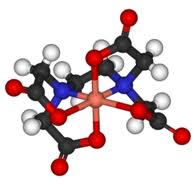Coloured complexes
 13.2 Coloured complexes (2 hours)
13.2 Coloured complexes (2 hours)
Pause for thought
Ligands
The definition of a ligand is that it is a neutral molecule or negative ion that donates one or more pairs of electrons to a metal atom or ion to form a coordination complex. Since it donates one or more pairs of electrons, by definition a ligand is also a Lewis base. The IB covers both monodentate ligands - that is ligands which only form just one coordinate bond with a transition metal - and polydentate ligands. Monodentate ligands include H2O, Cl–, CN–, NH3 and OH–. Polydentate (many teeth) ligands can form more than one coordinate bond with the transition metal atom or ion. They tend to bind quite strongly. As well as the three polydentate ligands (1,2-ethanediamine, ethanedioate and EDTA) that appear in Section 16 of the data booklet others appear on the syllabus in the options, for example porphyrins in Option B - Biochemistry and EDTA in the chelation of heavy metal ions in Option A - Materials. The concentration of transition metal complexes can be analyzed using visible spectroscopy. This can provide fertile ground for the Individual Scientific Investigation and for Extended Essays. EDTA, which is much used for chemical analysis, does have an IUPAC name but it is still routinely known by its common name EthyleneDiammineTetraAcetic acid or in its ionic form (see below) ethylenediaminetetraacetate. The non-bonding pairs of electrons on each of the two nitrogen atoms (blue in the diagram) and non-bonding pairs of electrons on each of the four oxygen atoms of the ethanoate (acetate) groups (red in the diagram) can all form coordinate bonds to a metal ion such as Cu2+.


The free ligand ethylenediaminetetraacetate (left) and acting as a hexadentate ligand with Cu2+ (right).
Although probably not on the syllabus it is worth noting that some polydentate ligands can cause optical isomerism when they bond to transition metal ions. For example, when ethane-1.2-diamine (1,2-ethanediamine) reacts with the cobalt(III) ion two possible enantiomers can be formed.

Three ethane-1,2-diamine bidentate ligands can form two different enantiomers with Co3+
Nature of Science
The different colours of transition metal complexes can be explained through the use of models and theories. The surrounding ligands cause the d-orbitals to split and the colour is the result of electronic transitions between the split d-orbitals.
Colour linked to symmetry cuts across disciplines and can be explored in the sciences, architecture, and the arts.
Learning outcomesAfter studying this topic students should be able to: Understand:
Apply their knowledge to:
| Clarification notesThe spectrochemical series is given in Section 15 of the data booklet. The structures and names of three polydentate ligands are given in Section 16 of the data booklet. Students are not expected to know the colour of specific complex ions. The colour wheel in Section 17 of the data booklet illustrates the relationship between the observed and absorbed colours. International-mindednessNothing is listed on the syllabus under this heading. |
Teaching tipsYou will need to stress several points if students are to really understand this topic. They need to know how many d electrons are present in the transition element or its ion and realize that complexes are only coloured if the d sub-level is partially filled. Although they do not need to know the shapes of the five d orbitals it is helpful to know that two of them lie along the axes and three of them lie between the axes. As the electron rich ligands approach the transition metal ion to form an octahedral complex they first 'see' the two that lie along the axes so these are moved to a slightly higher level which causes the splitting. Explain that the energy difference corresponds to the energy or wavelength (ΔE=hv) of visible light. When white light is shone on the complex it absorbs the colour corresponding to ΔE and so transmits the complementary colour (which is the colour observed). The actual colour will depend upon the size of the splitting which in turn is affected by the nature of the transition metal, its oxidation state and the electron density of the ligand. Low electron dense ligands such as I– cause the least splitting and high electron dense ligands such as CN– cause the greatest splitting. This leads to the concept of the spectrochemical series. Explain the difference between monodentate and polydentate ligands. Show them the reaction of copper(II) sulfate with concentrated hydrochloric acid and concentrated ammonia to show the effect of changing the ligand. It is also good to get them to use a spectrometer or colorimeter to make a calibration curve and use it to determine an unknown concentration of a complex transition metal ion in solution. | Study guide
Pages 21 - 22 QuestionsFor ten 'quiz' multiple choice questions with the answers explained see MC test: Coloured complexes . For short-answer questions which can be set as an assignment for a test, homework or given for self study together with model answers see Coloured complexes questions. Vocabulary listcomplex ion IM, TOK, Utilization etc.See separate page which covers all of Topics 3 & 13 Practical work
|
Teaching slides
Teachers may wish to share these slides with students for learning or for reviewing key concepts.
Other resources
1. A good video showing how the complexes of vanadium with different oxidation states have different colours.
2. A video of a solution of copper sulfate reacting with ammonia solution in slow motion by Nottingham University. But only show this if you cannot physically demonstrate it (it works much more dramatically with concentrated ammonia solution alternating with water and concentrated hydrochloric acid - in a fume cupboard!).
3. A video produced by the Royal Society of Chemistry explaining visible spectroscopy.
4. An animated video showing how the d orbitals are split as ligands approach. The splitting is well explained for tetrahedral complexes (which are not on the syllabus) but not quite so well-explained for octahedral complexes.
![]() Crystal field theory - splitting of d orbitals
Crystal field theory - splitting of d orbitals

 IB Docs (2) Team
IB Docs (2) Team 











